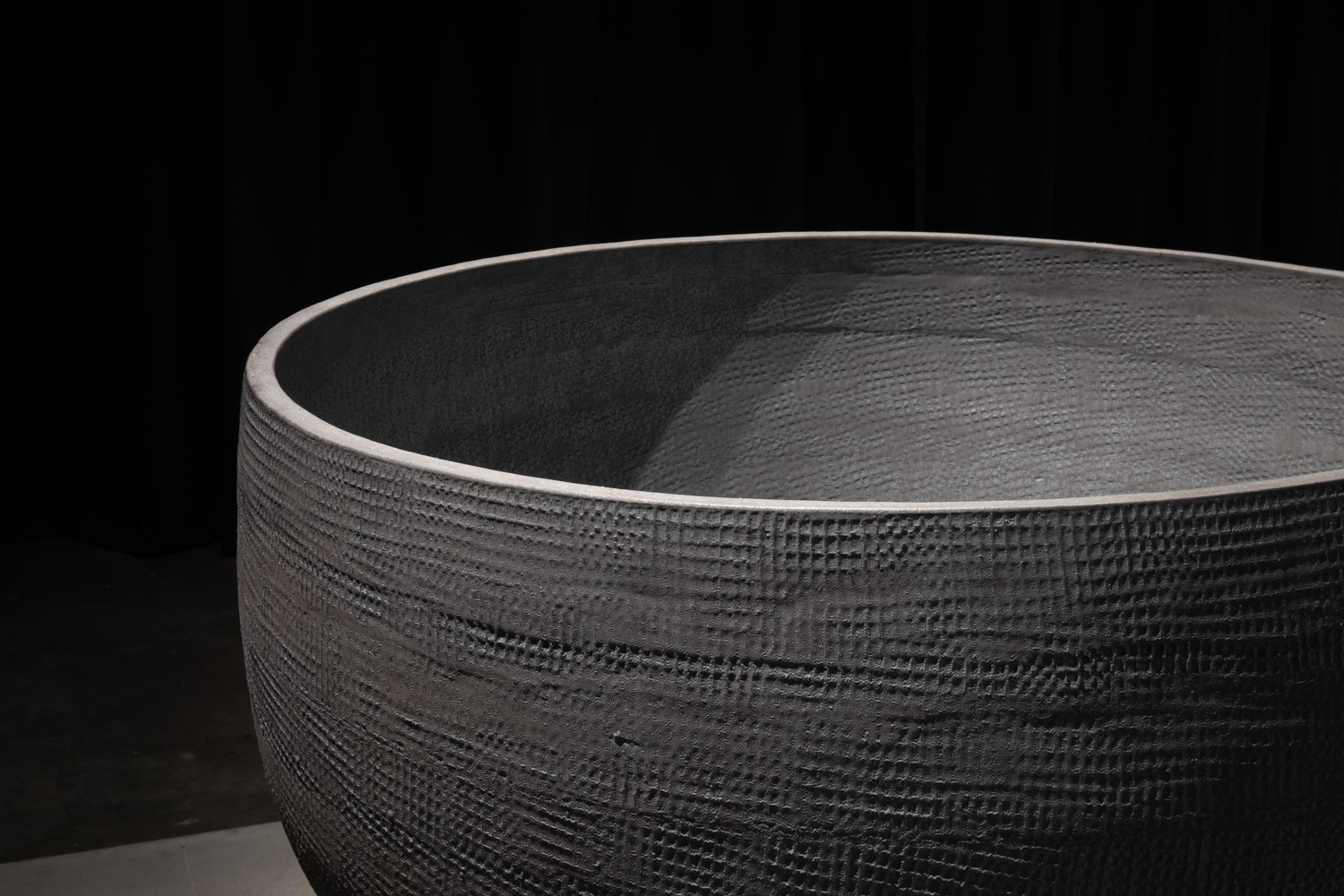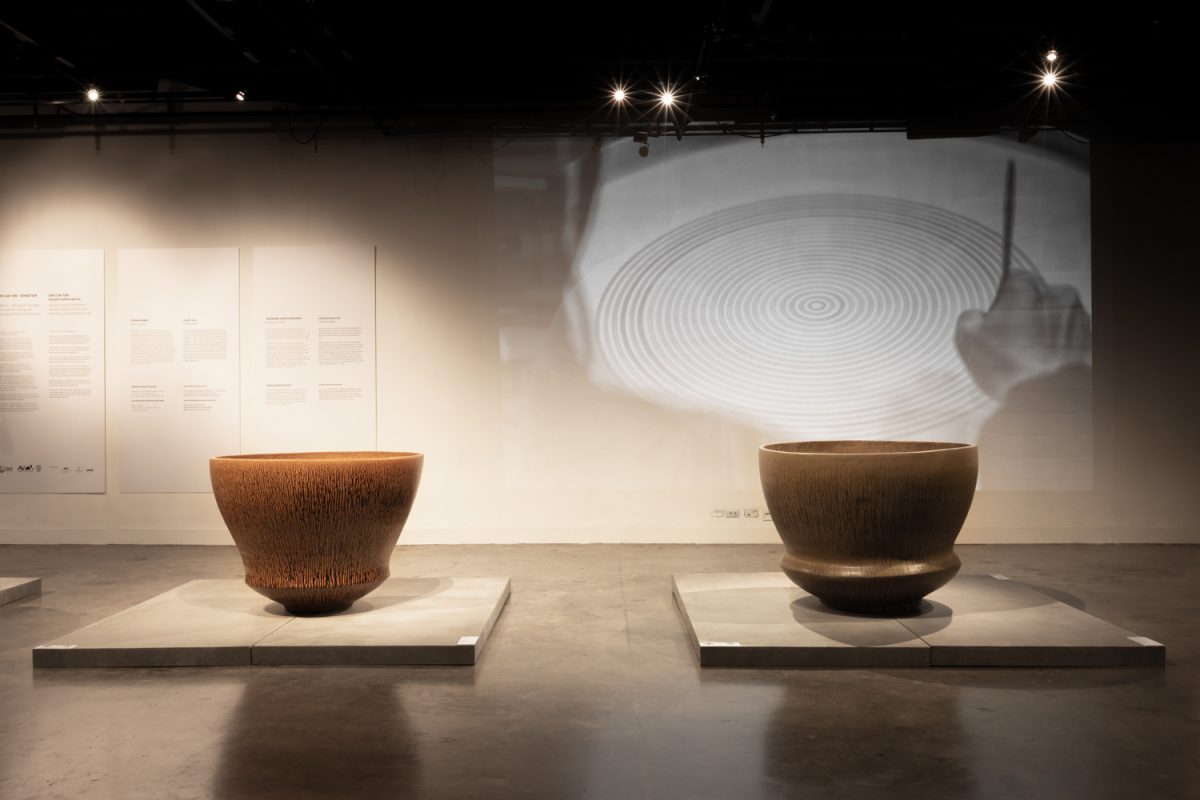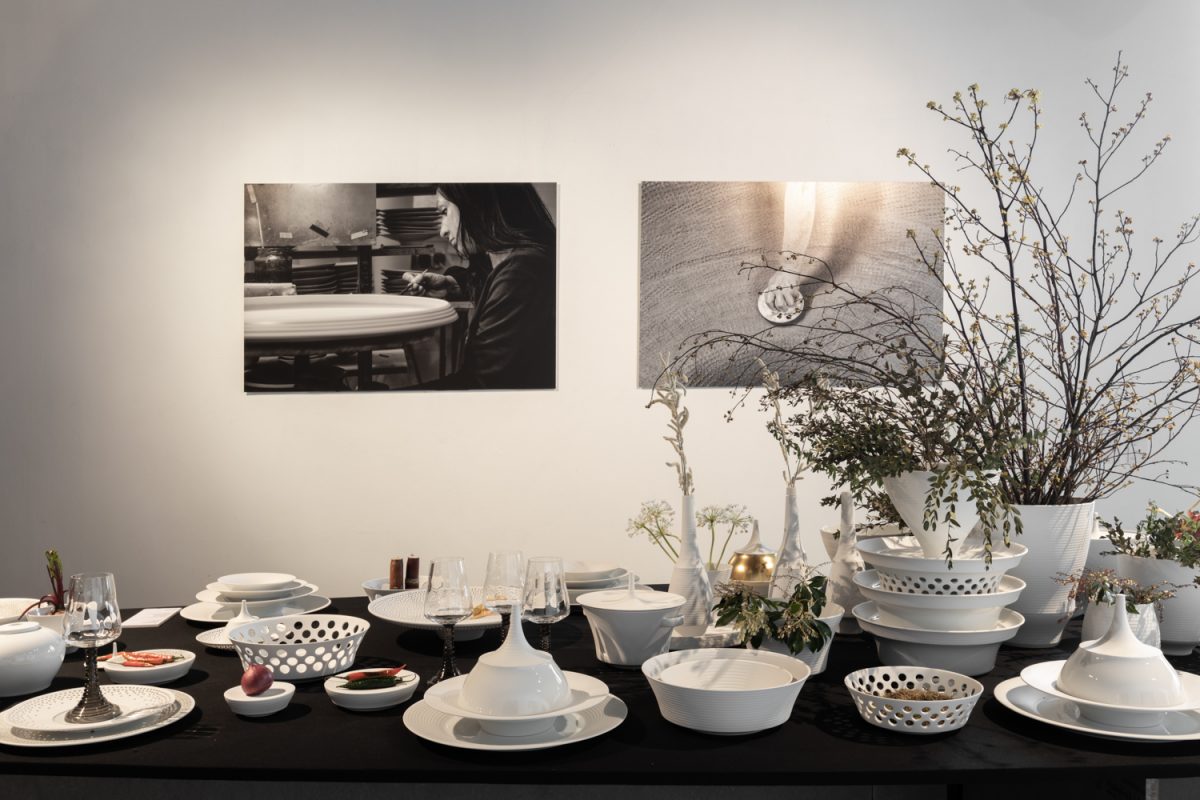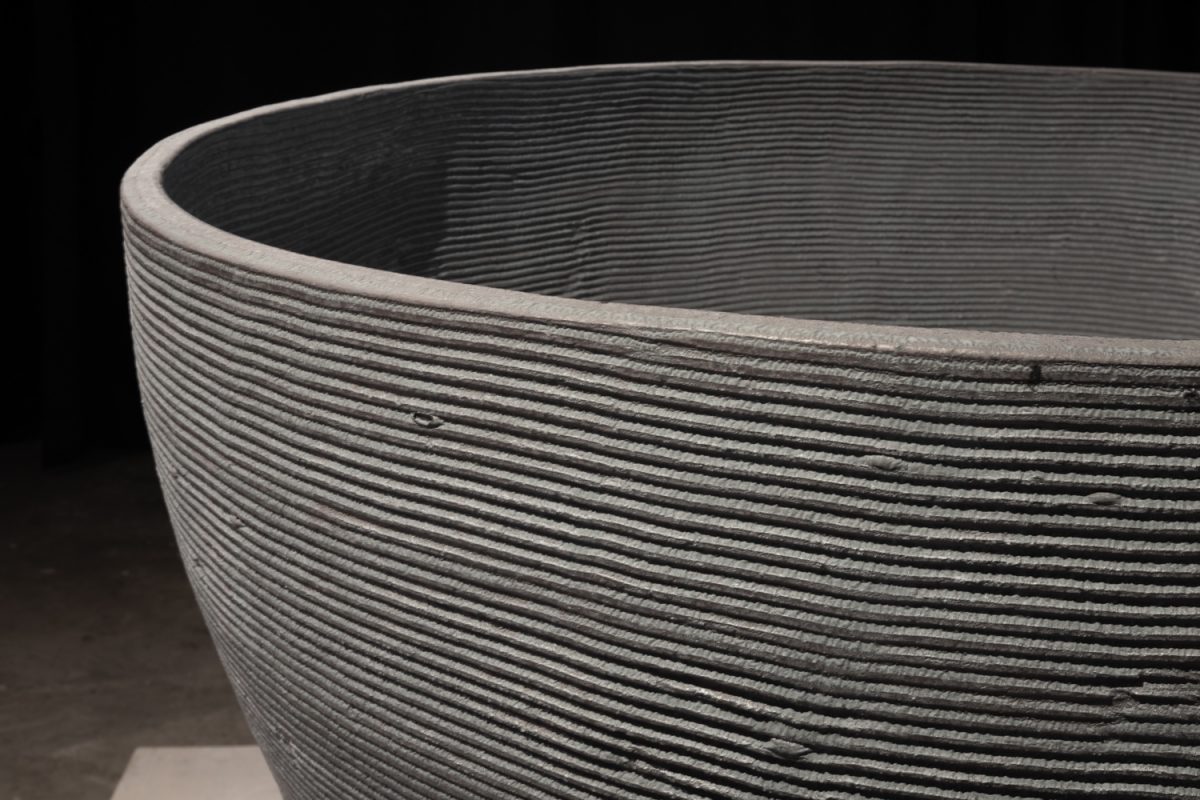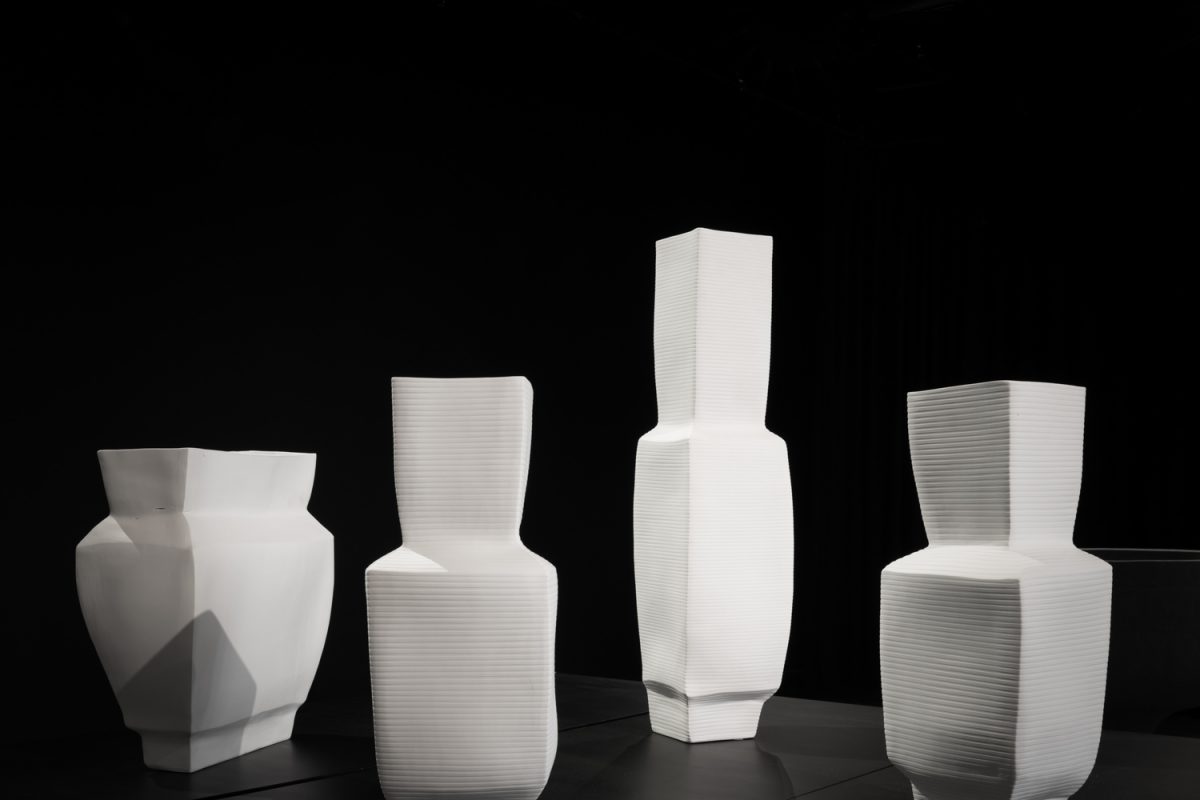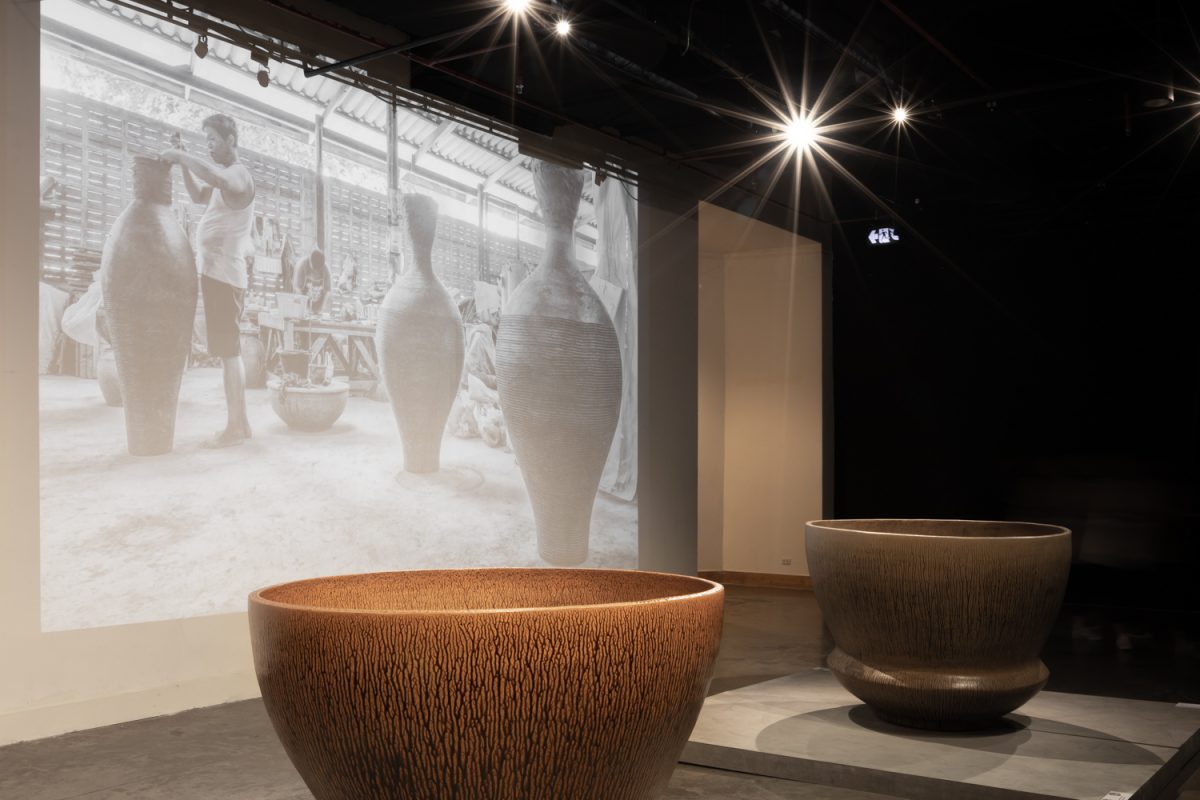THE COLLABORATION BETWEEN THAI AND GERMAN CERAMIC ARTISTS HAS CREATED SOMETHING TOGETHER TO FIND A LINK BETWEEN THE CULTURE OF CRAFT HIDDEN UNDER THE APPEARANCE OF A SIMPLE PIECE OF WORK.
TEXT: SUTEE NAKARAKORNKUL
PHOTO: KETSIREE WONGWAN
(For English, please scroll down)
“มันเริ่มมาจาก ผมบังเอิญเจอคุณ Maren Niemeyer ผู้อำนวยการสถาบันเกอเธ่ประจำประเทศไทยที่งานปาร์ตี้ต้อนรับ พอเขาทราบว่าผมทำงานเซรามิก ก็เลยพูดกับผมว่าเขากำลังจะเชิญ Stefanie Hering มาจัดนิทรรศการที่ไทย ผมรู้จักศิลปินคนนี้ไหม ผมก็ตอบไปเลยว่าทำไมจะไม่รู้จักล่ะครับ” วศินบุรี สุพานิชวรภาชน์ ศิลปินเซรามิก เล่าถึงที่มาของนิทรรศการ Din Clay Ton ที่จัดขึ้นที่หอศิลปวัฒนธรรมแห่งกรุงเทพมหานคร และเพิ่งจบลงไปเมื่อปลายเดือนมีนาคมที่ผ่านมานี้ ก่อนจะเสริมว่า นี่เป็นโอกาสดีๆ สำหรับคนไทย และนักศึกษาด้านเซรามิกที่จะได้มารับชมผลงานของศิลปินระดับตำนานคนนี้อย่างใกล้ชิด
หลายๆ คนที่ไปงานคงจะเจอเข้ากับงานเซรามิกขนาดใหญ่สีดำทะมึนทรวดทรงผอมบาง โอ่งขนาดใหญ่ที่มีฐานขนาดเล็กมาก แจกันสีขาวที่ดูเปราะบาง ไปจนถึงจานชามบนโต๊ะที่ดูปราดเดียวก็รู้ว่ามูลค่าของมันคงมีมูลค่าหลายหลัก งานเซรามิกสเกลใหญ่ๆ ในนิทรรศการนี้เกิดจากความร่วมมือกันระหว่าง Stefanie Hering ศิลปินเซรามิกชาวเยอรมันและช่างฝีมือชาวราชบุรี โดยมีโรงงานผลิตเครื่องเซรามิก ‘เถ้า ฮง ไถ่’ (ของ วศินบุรี สุพานิชวรภาชน์) เป็นสถานที่ทำงาน “รูปทรงที่เราเห็นว่าเป็น form ที่เรียบง่ายธรรมดาจริงๆ นั้นมันไม่ธรรมดา” ความต้องการของ Hering ครั้งนี้คือการทำงานเซรามิกสเกลใหญ่ที่หาคนทำในฝั่งยุโรปได้ยากมาก (เพราะคนในยุโรปเหนือไม่มีวัฒนธรรมการใช้ภาชนะเซรามิกขนาดใหญ่) ซึ่งตัวเธอเองก็ไม่เคยทำงานในสเกลใหญ่ขนาดนี้มาก่อน ขั้นตอนการขึ้นรูปชิ้นงานเบื้องต้นจึงตกเป็นของช่างเซรามิกในโรงงาน ที่จะทำงานตามแบบร่างที่ Hering สเก็ตช์ให้
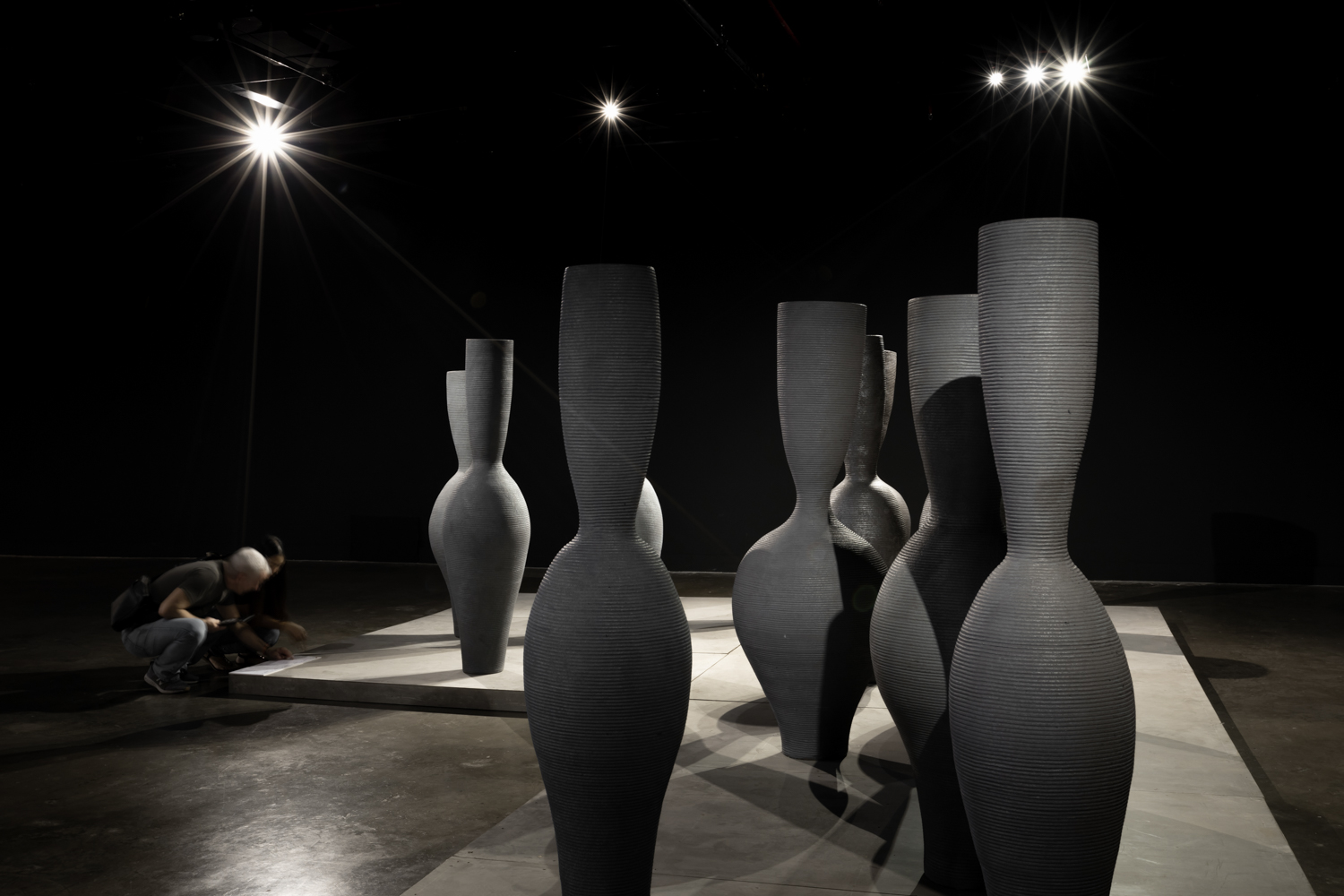
ชิ้นงานเกือบทั้งหมดเป็นรูปทรงลักษณะการทำงานเฉพาะตัวของ Hering คือเป็นชามก้นเล็ก ฐานแคบ มีการขูด texture รอบๆ เป็นเส้น ซึ่งเป็นสิ่งที่ปรากฏในงานพอร์ซเลนของเธอมาอย่างสม่ำเสมอ นอกเหนือไปจากการทำงานตามแบบสเกตช์แล้ว Hering ก็ได้นำดินราชบุรีมาปั้นเป็นแจกันรูปทรงที่เธอต้องการ จากนั้นก็ส่งงานชุดนี้กลับไปที่เยอรมนีและถอดพิมพ์ออกมาทำเป็นพอร์ซเลน วศินบุรีบอกกับ art4d ว่าวิธีการทำงานลักษณะนี้เขาคิดว่ามันคล้ายกับการสร้างบทสนทนาของการแลกเปลี่ยนระหว่างสองวัฒนธรรม ที่เชื่อมโยงกันด้วยเทคนิคและความเป็นไปได้ของวัสดุ “ดินที่เรามีกับรูปทรงและเทคนิคการทำพอร์ซเลนที่เขาคุ้นเคย เมื่อสร้างออกมาแล้วมันจะเกิดหลากหลายเอฟเฟ็กต์ของงาน ความเพอร์เฟ็กต์ ความเนี้ยบ ความดิบ ความเรียบง่าย หรือความไม่สมบูรณ์ในบางอย่าง เราจะเอาทุกอย่างนี้มาผสมกันให้กลายเป็นงานชิ้นใหม่ได้อย่างไร จุดนี้เองก็เป็นจุดที่น่าสนใจสำหรับนิทรรศการในครั้งนี้ด้วย”
การผสมผสานและความแตกต่างทางด้านเทคนิค ยังแสดงให้เห็นในชามขนาดใหญ่สองชิ้นที่จัดวางข้างกัน ใบหนึ่งเป็นรูปแบบการตกแต่งภาชนะแบบดั้งเดิมของการทำโอ่งที่ราชบุรี คือการทำ texture สี่เหลี่ยมโดยนำเครื่องมือมาทุบๆ ซ้อนกันให้กลายเป็นเลเยอร์ทรงจัตุรัส ส่วนอีกใบเป็นพื้นผิวลายเส้นตรงรอบขอบภาชนะ ซึ่งเป็นลักษณะการทำงานเฉพาะตัวของ Hering นอกจากนี้ยังมีผลงานอีกส่วนที่วศินบุรีได้หยิบเทคนิคการเคลือบเครื่องปั้นดินเผาลวดลายเหมือนสีไหลย้อย ที่เป็นคาแร็คเตอร์ของเครื่องปั้นดินเผาในเอเชียและบ้านเรา มาให้ Hering ได้ทดลองทำอีกเช่นกัน
กลับมาที่ผลงานของวศินบุรีในนิทรรศการกันบ้างนั่นคือภาพถ่ายพอร์ตเทรตช่างไทย – เยอรมัน ที่จัดแสดงอยู่ในห้องเล็กด้านในสุดของห้องนิทรรศการ “ผมไม่ได้ต้องการถ่ายภาพ ที่จะเป็นเครื่องเตือนใจให้คนอีก 20 ปีข้างหน้า มาเห็นแล้วทึ่งว่า โอโห เมื่อก่อนเขาใช้มือปั้นกันหรอ (เพราะตอนนั้นการปั้นด้วยมือมันหายไปจากการรับรู้ของคน) แต่ผมอยากให้คนมาดูภาพนี้ รู้ตัวว่ามันยังไม่สายเกินไปที่จะรักษาสิ่งนี้เอาไว้” นี่คือคำตอบของวศินบุรี เมื่อ art4d ถามถึงภาพถ่ายเหล่านั้น เราคิดว่าเรายังเห็นความเชื่อมโยงอีกอย่างระหว่างภาพถ่ายกับงานเซรามิกในนิทรรศการนี้ ภาพพอร์ทเทรตที่โฟกัสไปยังริ้วรอยบนใบหน้าช่างและผิวมืออันหยาบกร้าน อาจเทียบเคียงกันได้กับพื้นผิวของเซรามิก ที่ บางครั้งมันก็ไม่ได้เรียบเนียนเหมือนสินค้าอุตสาหกรรม แต่มีความงาม มีลายมือของช่างซ่อนอยู่ในนั้น ภาพถ่ายที่สื่อสารอย่างตรงไปตรงมาไม่ซับซ้อนนี้ จึงมีความหมายเรียบง่ายเหมือนชื่อของนิทรรศการ Din Clay Ton ที่แปลว่า “ดิน” ในภาษาไทย สากล (อังกฤษ) และเยอรมันตามลำดับ วัสดุพื้นๆ ที่มีอยู่ทั่วไปนี้ ได้เป็นตัวเชื่อมร้อยทุกสิ่งทุกอย่างที่เกิดขึ้นในนิทรรศการ เพียงแต่ว่ามันไม่ได้วางตัวอยู่โดดๆ แต่ก่อตัวขึ้นด้วยภาษาทางศิลปะที่ศิลปินทั้งสองสร้างขึ้นร่วมกัน

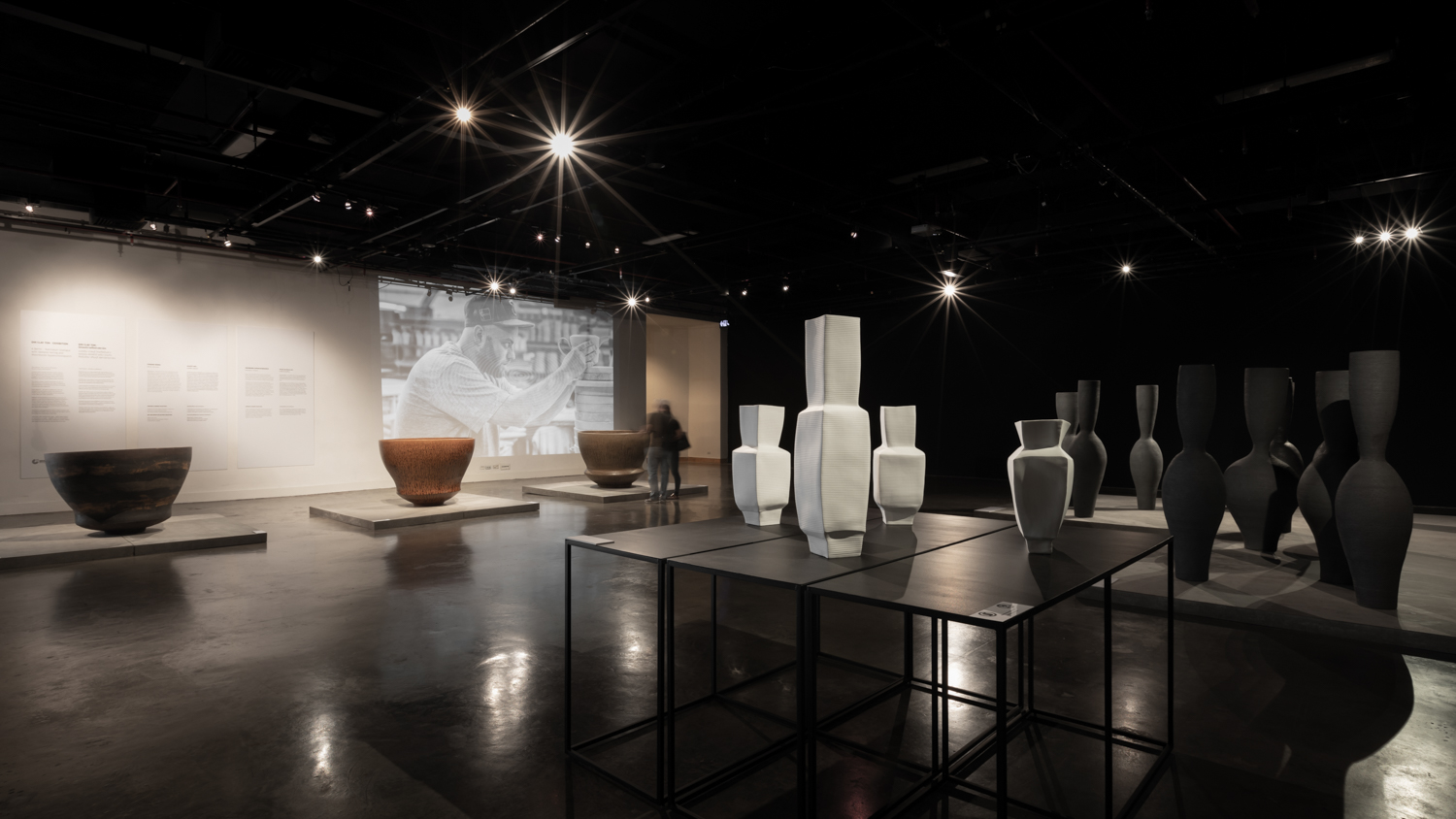
“It all started with me coincidentally running into Maren Niemeyer, Head of the Goethe-Institut in Thailand, at a reception party. We introduced each other and once he found out about my experience in ceramics, he told me that he was about to invite Stefanie Hering to do an exhibition in Thailand and whether I was familiar with her work, to which I replied ‘how could I not’,” recalled, Wasinburee Supanichvoraparch, ceramic artist about the genesis of Din Clay Ton exhibition held and recently ended in March at Bangkok Art and Culture Center before adding how the exhibition is a great opportunity for Thai people and students who study ceramic art and production to personally experience the works of this legendary artist.
Entering the exhibition space, one would encounter a bunch of tall, slender and dark-colored ceramic structures, a large porcelain jar with incredibly small base, a white vase with physically delicate shape all the way to the expensive-looking plates and bowls beautifully displayed on the table. German ceramic artist, Stefanie Hering worked together with a group of local artisans from Ratchaburi to create the large-scale pieces with Tao Hong Tai Ceramics Factory (owned and ran by Wasinburee Supanichvoraparch as the venue where the collaboration took place. “The forms look simple but there’s nothing simple about them.” Hering’s wish from this collaboration is to create large-scale ceramic pieces; something she had never had the chance to do in Europe (mainly in Northern Europe culture, people haven’t really used ceramic ware of such large scale), for it’s very difficult to find a place or an artisan who can produce work of such scale. New to the experience, Hering had the artisans work their craft in creating the molds following her sketches.
Most of the pieces express Hering’s artistic style, which essentially ceramic pieces with small, narrow base with decorative motif on the texture that is commonly found in her previous works. In addition to the sketches, Hering sculpted a series of vases using Ratchaburi’s local clay. The works were later shipped to Germany and used as molds for her porcelain pieces. Supanichvoraparch told art4d that this working process is pretty much like the conversations between two different cultures are exchanged and connected through craftsmanship techniques and the possibilities the material can offer. “The clay here when combined to the form and porcelain techniques she’s been doing all her life create interesting effects and results. It’s everything; the perfection, streamlined forms and details, rawness, simplicity as well as imperfection. The way these element are integrated into new ceramic creations is what interesting about the exhibition.”

Such combination and differences of techniques are reflected in the two sizable plates displayed next to each other. One contains traditional decorative technique commonly used in the making of Ratchaburi ceramic jar by using a tool to press on the surface to create a pattern of layered square-shapes. The other reveals Hering’s artistic style with the pattern made up of a series of straight lines visible around the edge of the plate. There is a number of works that are created from Hering’s experimentation on the color coating technique introduced to her by Supanichvoraparch, which gives the final result of dripping color effect, one of the decorative characteristics found in Asian and Thai ceramic ware.
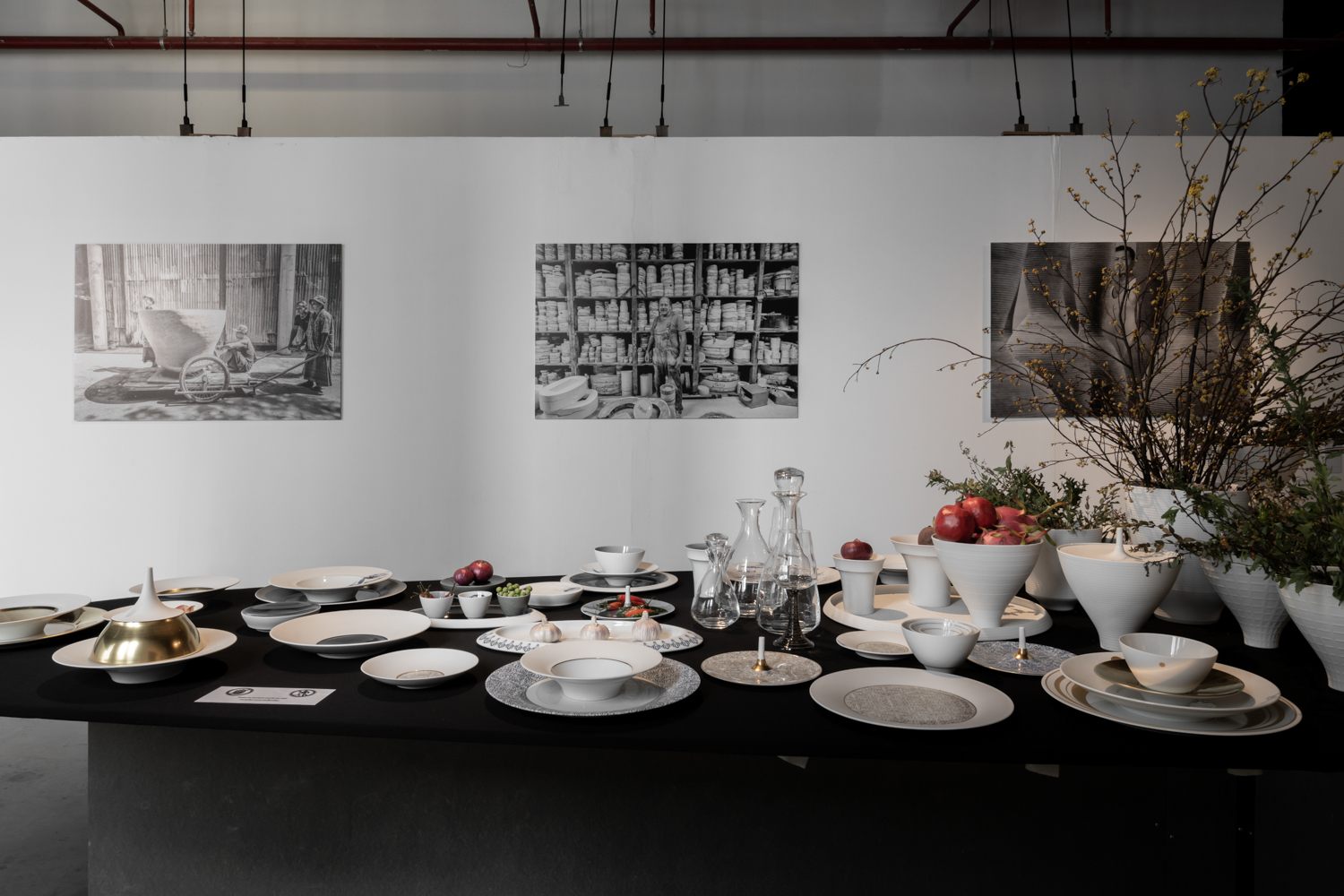
Meanwhile, Supanichvoraparch’s part in this exhibition is delivered in the form of a series of portraits of Thai and German ceramic artisans, which is exhibited in a small exhibition room located to the furthest part of the exhibition space. “I didn’t necessarily want to take the photographs to remind people twenty years from now to see and be amazed by the fact that these works are really made by humans’ hands (presumably handmade products will likely to disappear from most people’s knowledge). I want people to see these photos and realize that it isn’t too late to preserve this.” Supanichvoraparch answered to art4d’s question about the intention behind the photographs. We see another connection between the images he captured and the ceramic creations featured in this exhibition. The wrinkles on the faces of the artisan, the ridges and creases on their hands are like the surface of these handmade ceramics. They are not flawless and identical like most mass-produced industrial products. What they possess are the beauty and each artisan’s intrinsic signature. Through these photographs, the message is straightforwardly communicated. It’s simple just like the name, Din Clay Ton, of the exhibition itself (Din and Ton are Thai and German word for ‘clay’). With this rudimentary material, things become intertwined; taking shape; materialized from artistic language that Wasinburee Supanichvoraparch and Stefanie Hering together create.

